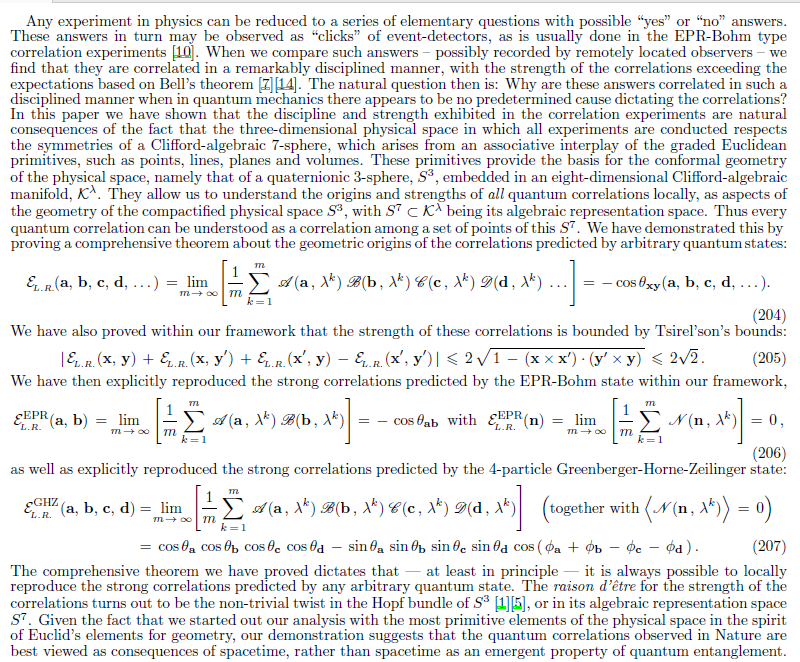Joy Christian wrote:***
Thank you, lkcl, for your comments. My primary purpose in the paper linked above is to understand the origins of quantum correlations in terms of the most primitive elements of the very geometry of spacetime, with the so-called quantum entanglement (and hence quantum mechanics) resulting as a byproduct. Specific problems of particle physics is not my concern in the above paper (for that see
https://arxiv.org/abs/1705.06036). Fred Diether and I did try to understand SU(3) symmetry within the framework I have presented in the above paper, but without success. Perhaps we didn't try hard enough, because I got distracted by other mundane things in life.
***
hiya joy (and freddy - read your message too), good to hear from you. my feeling is: SU(3) and so on, whilst technically correct, are red herrings: avenues that, if attempted to be pursued, will not yield results. there are many reasons for this, not least is that there are simply far too many *postulated* values in the standard model which have no explanation.
dr mill's work is, staggeringly, derived from scratch on a firm theoretical basis using nothing more than Maxwell's Equations. however he has to use some rather obscure maths (that's not available in electronic form, only in books) - 2 Dimensional Fourier Transforms which he extends to 3 - in order to do it.
the thing that he missed, however, is the beautiful geometry that you've noted. i really meant it when i said that the geometric patterns are key. in the Extended Rishon Model i noted that there has been a mistake made - including by me - where everyone who has explored the Rishon Model has not noted that the Rishon Model patterns describe twelve PHASES, and that those phases exactly and precisely correlate with a looped photon's EM field in a phase-stable, phase-harmonic pattern. Y(theta,phi), spinors, Poincare Spheres, SU(2)xU(1) - all these things describe exactly the same underlying "thing", just from different perspectives... none of which have the complete picture.
the point is: it is purely a coincidence of *geometry* - sin(30) = 1/2 - that the Rishons in T (which represents the "real" part of the looped photon's phase...) and V (representing the "complex) happen to add up to a total of 1.... but it's the *phase angles* represented by Rishon Triplets that *also* have to add up, matching specifically to a N,S,E,W compass point (1, -1, i or -i in complex space)... and this is only possible to achieve with equilateral triangles, hence why we only have 12 fundamental particles.
what i did not realise until some time at the beginning of this year is that the phases of the fundamental particles (electron, quarks, neutrino) happen to match precisely and exactly with the weinberg mixing angle (12 phases, 30 degrees apart), which happens then when you combine them to obey geometric patterns which *happen* to fit precisely with the E8 Lie Group.
you have a huge piece of the puzzle here. unfortunately.... i am a computer scientist with extremely advanced reverse-engineering skills. i am not a mathematician. if i were to tackle the required mathematics to deal with the (key) mistakes that Dr Randall Mills made, it would be about.... 4 years of full-time work before i had the necessary expertise. i simply can't do that... and feed myself and my family at the same time. or complete any of the other goals that i have set.
by contrast: someone who has the prerequisite mathematical expertise - which doesn't actually involve anything more complex than differentiation and integration, FFTs and so on, where there are plenty of pre-existing formulae to start from, and even Mathematica scripts - could probably complete this in about 2-3 months flat, without really having to think very hard about it.
i'd really love for this to be tackled in a public and open fashion, as that's what i am used to dealing with. i just haven't yet found a suitable forum or environment. do you have any suggestions?



